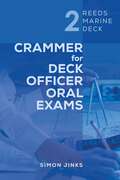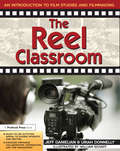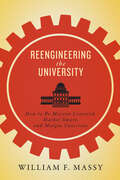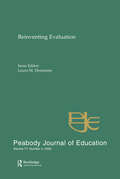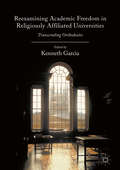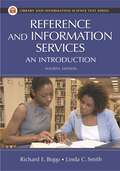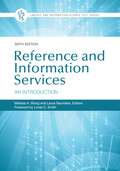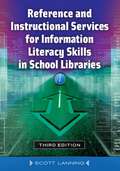- Table View
- List View
Reducing the Risk, Increasing the Promise: Strategies for Student Success
by Sherrell Bergmann Judith BroughIn their new book, Bergmann and Brough provide a clear path to follow for helping your at-risk students achieve success in and out of the classroom. Packed with classroom-tested, practical strategies and lesson plans for teaching respect, responsibility, resilience, reading, and other essential skills to at-risk students, this is a must-have book for educators at all levels. Use the plans alone, or as part of a unit. Either way, the tools for success in this book will help you positively impact the lives of at-risk students every day. Each chapter is dedicated to a different skill and offers easy-to-implement activities and strategies based on achieving success in that essential skill. For example: Strategies for establishing positive peer relationships Cooperative treasure hunting for resilience building Keys to structured role-playing for conflict resolution Each chapter includes a component about what parents and caregivers can do to help their at-risk children achieve success, and provides a basis for effective communication between educator and parent, an important piece of the puzzle often overlooked.
Reduction of Nonlinear Control Systems: A Differential Geometric Approach (Mathematics and Its Applications #472)
by V.I. ElkinAdvances in science and technology necessitate the use of increasingly-complicated dynamic control processes. Undoubtedly, sophisticated mathematical models are also concurrently elaborated for these processes. In particular, linear dynamic control systems iJ = Ay + Bu, y E M C ]Rn, U E ]RT, (1) where A and B are constants, are often abandoned in favor of nonlinear dynamic control systems (2) which, in addition, contain a large number of equations. The solution of problems for multidimensional nonlinear control systems en counters serious difficulties, which are both mathematical and technical in nature. Therefore it is imperative to develop methods of reduction of nonlinear systems to a simpler form, for example, decomposition into systems of lesser dimension. Approaches to reduction are diverse, in particular, techniques based on approxi mation methods. In this monograph, we elaborate the most natural and obvious (in our opinion) approach, which is essentially inherent in any theory of math ematical entities, for instance, in the theory of linear spaces, theory of groups, etc. Reduction in our interpretation is based on assigning to the initial object an isomorphic object, a quotient object, and a subobject. In the theory of linear spaces, for instance, reduction consists in reducing to an isomorphic linear space, quotient space, and subspace. Strictly speaking, the exposition of any mathemat ical theory essentially begins with the introduction of these reduced objects and determination of their basic properties in relation to the initial object.
Reeds Marine Deck 1: Collision Regulations Handbook (Reeds Marine Deck)
by Simon JinksA practical and user-friendly guide to the collision regulations, with full interpretations of the rules and clear diagrams. A thorough understanding of the International Regulations for the Prevention of Collisions at Sea (ColRegs) is essential for a wide range of professionals as well as amateur mariners. Written in legal text rather than easy to understand terminology, it is not a surprise that the Colregs are subject to gross misunderstanding and confusion. This makes this a difficult area for the thousands of mariners who need to learn, understand and remember them.This handbook is the answer. Expert marine training director Simon Jinks provides straightforward explanations of the complex situations that the Regulations discuss. He gives simple and comprehensive interpretation of the ColRegs rule by rule, giving students and professionals the clarity they need for exam prep and dealing with real-life situations. Colour illustrations of all lights and shapes, and clear diagrams provide additional support for students. The handbook also includes chapters on bridge watch-keeping, radar plotting and techniques for answering ColRegs questions in MCA exam conditions. It shows you where other maritime regulations work hand-in-hand with ColRegs.Simon Jinks is an experienced teacher of ColRegs to students who are studying for MCA Masters, OOW, Boat master and Chief Mates exams, plus those who are studying for RYA Yachtmasters and IYT Master of Yacht Qualifications and want to have an in-depth knowledge. The book adapts the author's teaching notes, developed over many years, with added extras around the subject to help in greater understanding.
Reeds Marine Deck 1: Collision Regulations Handbook (Reeds Marine Deck)
by Simon JinksA practical and user-friendly guide to the collision regulations, with full interpretations of the rules and clear diagrams. A thorough understanding of the International Regulations for the Prevention of Collisions at Sea (ColRegs) is essential for a wide range of professionals as well as amateur mariners. Written in legal text rather than easy to understand terminology, it is not a surprise that the Colregs are subject to gross misunderstanding and confusion. This makes this a difficult area for the thousands of mariners who need to learn, understand and remember them.This handbook is the answer. Expert marine training director Simon Jinks provides straightforward explanations of the complex situations that the Regulations discuss. He gives simple and comprehensive interpretation of the ColRegs rule by rule, giving students and professionals the clarity they need for exam prep and dealing with real-life situations. Colour illustrations of all lights and shapes, and clear diagrams provide additional support for students. The handbook also includes chapters on bridge watch-keeping, radar plotting and techniques for answering ColRegs questions in MCA exam conditions. It shows you where other maritime regulations work hand-in-hand with ColRegs.Simon Jinks is an experienced teacher of ColRegs to students who are studying for MCA Masters, OOW, Boat master and Chief Mates exams, plus those who are studying for RYA Yachtmasters and IYT Master of Yacht Qualifications and want to have an in-depth knowledge. The book adapts the author's teaching notes, developed over many years, with added extras around the subject to help in greater understanding.
Reeds Marine Deck 2: Crammer for Deck Officer Oral Exams (Reeds Marine Deck)
by Simon JinksA no-nonsense study guide helping seafarers to pass their MCA or Flag State oral exams for Deck Officer qualifications. This handy revision guide is the one book that Deck Officer Cadets, Master and Deck Officers will want by their side when studying for the much-feared oral exams. Expert marine training director Simon Jinks strips back the masses of information to the core essential points that are easy to absorb and quick to remember when it comes to the oral assessment.The MCA Deck Officer (Officer of the Watch, Chief Mate and Master) syllabi cover a vast amount of information that candidates are required to understand and use in their oral exam, which for many presents a major stumbling block to qualification. While it inevitably takes a long time for candidates to build up this wealth of knowledge, this study aid is the perfect refresher, listing the key points and including helpful sample questions and worked examples on tidal working, radar plotting and more.Written in simple terms, this trusted crammer covers all the principal areas of the MCA's exam syllabus, including sections on business and law conventions, pollution prevention, responses to emergencies and distress signals. Clearly presented, it is packed with straightforward diagrams and flow charts, making it ideal for revising.This is an invaluable reference for all international STCW Deck Officer candidates, and covers both MCA and Flag State oral exams. It is also suitable for Near Coastal and Boatmaster apprentices, Workboat crew apprentices, Yachtmaster Offshores, Yachtmaster instructors, and fishermen going for their fishing licences on larger vessels, and for shore workers such as vessel superintendents, maritime managers and trainers. There is specific information for all vessels, with sections on smaller, code and domestic vessels.
Reeds Vol 2: Applied Mechanics for Marine Engineers (Reeds Marine Engineering and Technology Series)
by Paul Anthony RussellThis book covers the principal topics in applied mechanics for professional trainees studying Merchant Navy Marine Engineering Certificates of Competency (CoC) as well as the core syllabi in applied mechanics for undergraduates studying for BSc, BEng and MEng degrees in marine engineering, naval architecture and other marine technology related programmes.This new edition has been fully updated to reflect the recent changes to the Merchant Navy syllabus and current pathways to a sea-going engineering career, specifically the increased emphasis that has been placed on colleges and universities now responsible for the academic requirements for those studying for a career in marine engineering. In particular this means the book has been updated to include more information about the general principles and applications of the exercises in the practical world of marine engineering.Each chapter has fully worked examples interwoven into the text, with test examples set at the end of each chapter. Other revisions include examples reflecting modern machines and practice, current legislation and current syllabi.
Reeds Vol 4: Naval Architecture for Marine Engineers (Reeds Marine Engineering and Technology Series)
by Dr Richard Pemberton E A StokoeThe essential textbook for all students preparing for Marine Engineer Officer exams.Covering the theoretical, fundamental aspects of naval architecture, this textbook is aimed at students preparing for the Class 1 and Class 2 Marine Engineer Officer exams. It introduces the foundation themes within naval architecture (hydrostatics, stability, resistance and powering), using worked examples to show how solutions should be presented for an exam.The topics are ordered as they might be in a typical taught module, to aid the use of the book by lecturers as a complement to a course. The text and figures continue to be updated in line with modern practice. Many of the figures are three-dimensional diagrams. The book also includes sample examination questions with worked examples to aid students in their learning.As well as an expanded section on stability that considers inclining experiments, this new edition also factors in changes within the industry as it moves towards Net Zero propulsion. Due to the pace of innovation, students who qualify today will see big changes during their careers, and this edition anticipates this and prepares students for such developments.
Reeds Vol 4: Naval Architecture for Marine Engineers (Reeds Marine Engineering and Technology Series)
by E A Stokoe Dr Richard PembertonThe essential textbook for all students preparing for Marine Engineer Officer exams.Covering the theoretical, fundamental aspects of naval architecture, this textbook is aimed at students preparing for the Class 1 and Class 2 Marine Engineer Officer exams. It introduces the foundation themes within naval architecture (hydrostatics, stability, resistance and powering), using worked examples to show how solutions should be presented for an exam.The topics are ordered as they might be in a typical taught module, to aid the use of the book by lecturers as a complement to a course. The text and figures continue to be updated in line with modern practice. Many of the figures are three-dimensional diagrams. The book also includes sample examination questions with worked examples to aid students in their learning.As well as an expanded section on stability that considers inclining experiments, this new edition also factors in changes within the industry as it moves towards Net Zero propulsion. Due to the pace of innovation, students who qualify today will see big changes during their careers, and this edition anticipates this and prepares students for such developments.
Reeds Vol 5: Ship Construction for Marine Engineers (Reeds Marine Engineering and Technology Series)
by Paul Anthony Russell E A StokoeReeds Vol 5 covers ship construction techniques and methods for all classes of the Merchant Navy marine deck and engineering Certificates of Competency (CoC) as well as students studying for degrees and diplomas in Naval Architecture and Marine Engineering. It is complementary to Reeds Vol 4 (Naval Architecture) and Reeds Vol 8 (General Engineering Knowledge).This new edition will be fully updated to reflect the recent changes to the Merchant Navy syllabus and current pathways to a sea-going engineering career. The techniques and methods of ship's construction are continually changing especially as materials science develops at a rapid pace. Reeds Vol 5 needs to be updated to keep pace with these developments. In particular, there will be updated sections on composite technology which will open up the potential market in the UK as well as appealing to more of the international market. Extensively illustrated, the book will also include sample examination questions with worked example answers to aid students in their learning.
Reeds Vol 5: Ship Construction for Marine Engineers (Reeds Marine Engineering and Technology Series)
by Paul Anthony Russell E A StokoeReeds Vol 5 covers ship construction techniques and methods for all classes of the Merchant Navy marine deck and engineering Certificates of Competency (CoC) as well as students studying for degrees and diplomas in Naval Architecture and Marine Engineering. It is complementary to Reeds Vol 4 (Naval Architecture) and Reeds Vol 8 (General Engineering Knowledge).This new edition will be fully updated to reflect the recent changes to the Merchant Navy syllabus and current pathways to a sea-going engineering career. The techniques and methods of ship's construction are continually changing especially as materials science develops at a rapid pace. Reeds Vol 5 needs to be updated to keep pace with these developments. In particular, there will be updated sections on composite technology which will open up the potential market in the UK as well as appealing to more of the international market. Extensively illustrated, the book will also include sample examination questions with worked example answers to aid students in their learning.
Reeds Vol 8: General Engineering Knowledge for Marine Engineers (Reeds Marine Engineering and Technology Series)
by Paul Anthony RussellThe essential coursebook for all students studying general marine engineering.General Engineering Knowledge for Marine Engineers considers the different needs of those studying 'general' marine engineering, including the most recent changes to the Merchant Navy syllabus and current pathways to a sea-going engineering career.Accessibly written and clearly illustrated with technical engineering drawings, it covers all the latest equipment, practices and trends in marine engineering. It incorporates the 2010 Manila Amendments, particularly relating to management.This latest edition reflects all the developments in the field, including updates and additions on, amongst other things:- Sustainable ships systems- Hybrid power and energy management systems- Battery technology and hydrogen fuel cells- Biofuels- Waste heat recovery- Corrosion of metals in sea water- SOLAS rules on steering ships- Electric vehicle battery firesThe book includes test examples for student self-assessment, and these have also been reviewed and updated to ensure this volume remains current.
Reeds Vol 8: General Engineering Knowledge for Marine Engineers (Reeds Marine Engineering and Technology Series)
by Paul Anthony RussellThe essential coursebook for all students studying general marine engineering.General Engineering Knowledge for Marine Engineers considers the different needs of those studying 'general' marine engineering, including the most recent changes to the Merchant Navy syllabus and current pathways to a sea-going engineering career.Accessibly written and clearly illustrated with technical engineering drawings, it covers all the latest equipment, practices and trends in marine engineering. It incorporates the 2010 Manila Amendments, particularly relating to management.This latest edition reflects all the developments in the field, including updates and additions on, amongst other things:- Sustainable ships systems- Hybrid power and energy management systems- Battery technology and hydrogen fuel cells- Biofuels- Waste heat recovery- Corrosion of metals in sea water- SOLAS rules on steering ships- Electric vehicle battery firesThe book includes test examples for student self-assessment, and these have also been reviewed and updated to ensure this volume remains current.
The Reel Classroom: An Introduction to Film Studies and Filmmaking (Grades 6-9)
by Jeff DanielianThe Reel Classroom: An Introduction to Film Studies and Filmmaking presents an educator-facilitated curriculum that focuses on a variety of aspects concerning the appreciation of film and the filmmaking process. With a goal to turn "movie day" into a teaching and learning opportunity—rather than a virtual day off for students—this book will help invigorate classrooms of all disciplines by incorporating documentaries, feature films, short films, and animated films into the regular curriculum. Chapters begin with short and effective introductions to the specified concept with accompanying class discussion ideas and background information for the teacher. Each chapter will conclude with reproducible handouts and assignment sheets along with two to three sample activities/opportunities for assessment. Suggestions for films to be used for each discipline will also be given.Grades 6-9
The Reel Classroom: An Introduction to Film Studies and Filmmaking (Grades 6-9)
by Jeff DanielianThe Reel Classroom: An Introduction to Film Studies and Filmmaking presents an educator-facilitated curriculum that focuses on a variety of aspects concerning the appreciation of film and the filmmaking process. With a goal to turn "movie day" into a teaching and learning opportunity—rather than a virtual day off for students—this book will help invigorate classrooms of all disciplines by incorporating documentaries, feature films, short films, and animated films into the regular curriculum. Chapters begin with short and effective introductions to the specified concept with accompanying class discussion ideas and background information for the teacher. Each chapter will conclude with reproducible handouts and assignment sheets along with two to three sample activities/opportunities for assessment. Suggestions for films to be used for each discipline will also be given.Grades 6-9
Reengineering the University: How to Be Mission Centered, Market Smart, and Margin Conscious
by William F. MassyHigher education expert William F. Massy’s decades as a professor, senior university officer, and consultant have left him with a passionate belief in the need for reform in America’s traditional universities. In Reengineering the University, he addresses widespread concerns that higher education’s costs are too high, learning falls short of objectives, disruptive technology and education models are mounting serious challenges to traditional institutions, and administrators and faculty are too often unwilling or unable to change. An expert microeconomist, Massy approaches the challenge of reform in a genuinely new way by applying rigorous economic principles, informed by financial data and other evidence, to explain the forces at work on universities and the flaws in the academic business model. Ultimately, he argues that computer models that draw on data from college transaction systems can help both administrators and faculty address problems of educational performance and cost analysis, manage the complexity of planning and budgeting systems, and monitor the progress of reform in nonintrusive and constructive ways. Written for institutional leaders, faculty, board members, and policymakers who bear responsibility for initiating and carrying through on reform in traditional colleges and universities, Reengineering the University shows how, working together, administrators and faculty can improve education, research, and affordability by keeping a close eye on both academic values and the bottom line.
Reengineering the University: How to Be Mission Centered, Market Smart, and Margin Conscious
by William F. MassyHigher education expert William F. Massy’s decades as a professor, senior university officer, and consultant have left him with a passionate belief in the need for reform in America’s traditional universities. In Reengineering the University, he addresses widespread concerns that higher education’s costs are too high, learning falls short of objectives, disruptive technology and education models are mounting serious challenges to traditional institutions, and administrators and faculty are too often unwilling or unable to change. An expert microeconomist, Massy approaches the challenge of reform in a genuinely new way by applying rigorous economic principles, informed by financial data and other evidence, to explain the forces at work on universities and the flaws in the academic business model. Ultimately, he argues that computer models that draw on data from college transaction systems can help both administrators and faculty address problems of educational performance and cost analysis, manage the complexity of planning and budgeting systems, and monitor the progress of reform in nonintrusive and constructive ways. Written for institutional leaders, faculty, board members, and policymakers who bear responsibility for initiating and carrying through on reform in traditional colleges and universities, Reengineering the University shows how, working together, administrators and faculty can improve education, research, and affordability by keeping a close eye on both academic values and the bottom line.
Reevaluating Evaluation: A Special Issue of peabody Journal of Education
by Camilla Benbow James Guthrie Jason Walton Michele ThompsonIn the context of the evolution of education program evaluation and the current emphasis on scientific precision, this special issue presents several of the challenges to program evaluation that scholars are facing today. In addition, it shares recent insights and experiences that will contribute to continued improvement of program evaluation and responds to the call for more exactness without losing sight of the lessons learned from evaluation over the past several decades. The eight papers address five main areas: evaluation design, instrumentation, implementation, politics, and analysis. As a whole, this issue is designed shed light on the five issues, as well as provide information useful for those interested in increasing the rigor of education research to increase the ability to improve schools.
Reevaluating Evaluation: A Special Issue of peabody Journal of Education
by Laura M. DesimoneIn the context of the evolution of education program evaluation and the current emphasis on scientific precision, this special issue presents several of the challenges to program evaluation that scholars are facing today. In addition, it shares recent insights and experiences that will contribute to continued improvement of program evaluation and responds to the call for more exactness without losing sight of the lessons learned from evaluation over the past several decades. The eight papers address five main areas: evaluation design, instrumentation, implementation, politics, and analysis. As a whole, this issue is designed shed light on the five issues, as well as provide information useful for those interested in increasing the rigor of education research to increase the ability to improve schools.
Reexamining Academic Freedom in Religiously Affiliated Universities: Transcending Orthodoxies
by Kenneth GarciaKenneth Garcia presents an edited collection of papers from the 2015 conference on academic freedom at religiously affiliated universities, held at the University of Notre Dame. These essays reexamine the secular principle of academic freedom and discuss how a theological understanding might build on and further develop it. The year 2015 marked the 100th anniversary of the founding of the American Association of University Professors (AAUP), the leading advocate of academic freedom in America. In October 2015, the University of Notre Dame convened a group of prominent scholars to consider how the concept and practice of academic freedom might evolve. The premise behind the conference was that the current conventional understandings of academic freedom are primarily secular and, therefore, not yet complete. The goal was to consider alternative understandings in light of theological insight. Theological insight, in this context, refers to an awareness that there is a surplus of knowledge and meaning to reality that transcends what can be known through ordinary disciplinary methods of inquiry, especially those that are quantitative or empirical. Essays in this volume discuss how, in light of the fact that findings in many fields hint at connections to a greater whole, scholars in any academic field should be free to pursue those connections. Moreover, there are religious traditions that can help inform those connections.
Reference and Information Services: An Introduction (Library and Information Science Text Series)
by Richard E. Bopp Linda C. SmithReflecting the dramatic changes shaped by rapidly developing technologies over the past six years, this new fourth edition of Reference and Information Services takes the introduction to reference sources and services significantly beyond the content of the first three editions. In Part I, Concepts and Processes, chapters have been revised and updated to reflect new ideas and methods in the provision of reference service in an era when many users have access to the Web. In Part II, Information Sources and Their Use, discussion of each source type has been updated to encompass key resources in print and on the Web, where an increasing number of freely available sources join those purchased or licensed by libraries.A number of new authors are contributors to this new edition, bringing to their chapters their experience as teachers of reference and as practitioners in different types of libraries. Discussions of services in Part I integrate digital reference as appropriate to each topic, such as how to conduct a reference interview online using instant messaging. Boxes interspersed in the text are used to present scenarios for discussion, to highlight key concepts, or to present excerpts from important documents. Discussions of sources in Part II place more emphasis on designing effective search strategies using both print and digital resources. The chapter on selection and evaluation of sources addresses the changing nature of reference collections and how to evaluate new types of sources. Each chapter concludes with an updated list of additional readings to guide further study.A new companion website will provide links to Web-accessible readings and resources as well as additional scenarios for discussion and example search strategies to supplement those presented in the text.
Reference and Information Services: An Introduction (Library and Information Science Text Series)
by Melissa A. Wong and Laura SaundersWritten as a textbook for LIS students taking reference courses, this fully updated and revised seventh edition of Reference and Information Services: An Introduction also serves as a helpful handbook for practitioners to refamiliarize themselves with particular types and formats of sources and to refresh their knowledge on specific service topics.The first section grounds the rest of the textbook with an overview of the foundations of reference and an introduction to the theories, values, and standards that guide reference service. The second section provides an overview of reference services and techniques for service provision, establishing a foundation of knowledge on reference service and extending ethical and social justice perspectives. The third part offers an overview of the information life cycle and dissemination of information, followed by an in-depth examination of information sources by type as well as by broad subject areas. Finally, the concluding section guides the reader through the process of developing and maintaining their own vision of reference practice.This textbook is essential reading for all preservice and working librarians, particularly those concerned with ethical and social justice perspectives on reference work.
Reference and Information Services: An Introduction (Library and Information Science Text Series)
by Melissa A. Wong Laura SaundersThis revised and updated sixth edition of Reference and Information Services continues the book's rich tradition, covering all phases of reference and information services with less emphasis on print and more emphasis on strategies and scenarios.Reference and Information Services is the go-to textbook for MSLIS and i-School courses on reference services and related topics. It is also a helpful handbook for practitioners. Authors include LIS faculty and professionals who have relevant degrees in their areas and who have published extensively on their topics. The first half of the book provides an overview of reference services and techniques for service provision, including the reference interview, ethics, instruction, reader's advisory, and services to diverse populations including children. This part of the book establishes a foundation of knowledge on reference service and frames each topic with ethical and social justice perspectives. The second part of the book offers an overview of the information life cycle and dissemination of information, followed by an in-depth examination of information sources by type—including dictionaries, encyclopedias, indexes, and abstracts—as well as by broad subject areas including government, statistics and data, health, and legal information. This second section introduces the tools and resources that reference professionals use to provide the services described in the first half of the text.
Reference and Information Services: An Introduction (Library and Information Science Text Series)
This revised and updated sixth edition of Reference and Information Services continues the book's rich tradition, covering all phases of reference and information services with less emphasis on print and more emphasis on strategies and scenarios.Reference and Information Services is the go-to textbook for MSLIS and i-School courses on reference services and related topics. It is also a helpful handbook for practitioners. Authors include LIS faculty and professionals who have relevant degrees in their areas and who have published extensively on their topics. The first half of the book provides an overview of reference services and techniques for service provision, including the reference interview, ethics, instruction, reader's advisory, and services to diverse populations including children. This part of the book establishes a foundation of knowledge on reference service and frames each topic with ethical and social justice perspectives. The second part of the book offers an overview of the information life cycle and dissemination of information, followed by an in-depth examination of information sources by type—including dictionaries, encyclopedias, indexes, and abstracts—as well as by broad subject areas including government, statistics and data, health, and legal information. This second section introduces the tools and resources that reference professionals use to provide the services described in the first half of the text.
Reference and Information Services: An Introduction (Library and Information Science Text Series)
Written as a textbook for LIS students taking reference courses, this fully updated and revised seventh edition of Reference and Information Services: An Introduction also serves as a helpful handbook for practitioners to refamiliarize themselves with particular types and formats of sources and to refresh their knowledge on specific service topics.The first section grounds the rest of the textbook with an overview of the foundations of reference and an introduction to the theories, values, and standards that guide reference service. The second section provides an overview of reference services and techniques for service provision, establishing a foundation of knowledge on reference service and extending ethical and social justice perspectives. The third part offers an overview of the information life cycle and dissemination of information, followed by an in-depth examination of information sources by type as well as by broad subject areas. Finally, the concluding section guides the reader through the process of developing and maintaining their own vision of reference practice.This textbook is essential reading for all preservice and working librarians, particularly those concerned with ethical and social justice perspectives on reference work.
Reference and Instructional Services for Information Literacy Skills in School Libraries
by Scott LanningStudents need to be able to distinguish good information from bad. This book gives you the tools to transmit those essential skills to your students.Being an effective school librarian requires acting as an active instructional partner, an advocate for information literacy and information resources, and a reference librarian. Now in its third edition, this concise book provides you with a solid foundation in providing reference services to students as well as teachers. It details all aspects of providing essential reference services in the context of the AASL Standards, the Common Core State Standards, and the evolving role of today's school librarian.Author Scott Lanning emphasizes service and instruction while addressing topics such as inquiry, critical thinking, building core reference skills, electronic and Web resources, leadership skills, and virtual reference services. The book begins with chapters that discuss information and the information-seeking process. The following sections cover the provision of reference services, methods for teaching information literacy, the use of electronic resources in general, and the creation of library resources that support reference and instruction. The text concludes with an assessment of the value of reference and instruction services to the school and beyond.



